Development of Antimicrobial Biocomposite Films to Preserve the Quality of Bread
Abstract
:1. Introduction
2. Materials and Methods
2.1. Materials
2.2. Minimum Inhibitory Concentration of the Oleoresins
2.3. Physical-Chemical Analysis
2.4. Preparation of Films
2.5. Film Characterization
2.5.1. Humidity Content
2.5.2. Water Vapor Permeability
2.5.3. Mechanical Properties
2.5.4. Oil Permeability
2.5.5. Measurement of Seal Strength
2.5.6. X-ray Diffraction (XRD)
2.5.7. Fourier Transform Infrared (FTIR) Spectroscopy
2.5.8. UV-Vis Light Transmittance Values
2.5.9. Color
2.5.10. Thermogravimetric Analysis (TGA)
2.6. Influence of Biocomposite Films on Bread Quality
2.7. Physical-Chemical Evaluation of the Bread
2.8. Microbiological Evaluation of the Bread
2.9. Sensory Evaluation of the Bread
2.10. Statistical Analysis
3. Results and Discussion
3.1. Physical-Chemical and Microbiological Study of the Components of the Biocomposite Material
3.2. Characterization of Films
3.2.1. Humidity
3.2.2. Water Vapor Permeability
3.2.3. Mechanical Properties
3.2.4. Oil Permeability
3.2.5. UV-Vis Light Transmittance Values
3.2.6. Measurement of Seal Strength
3.2.7. X-ray Diffraction (XRD)
3.2.8. Fourier Transformed Infrared (FTIR) Spectroscopy
3.2.9. Color
3.2.10. Thermogravimetric Analysis (TGA)
3.3. Physical-Chemical Evaluation of the Bread
3.3.1. Moisture
3.3.2. pH
3.3.3. Water Activity (aw)
3.3.4. Weight Loss (%wl)
3.4. Microbiological Evaluation of the Bread
3.5. Sensory Analysis of the Bread
4. Conclusions
Acknowledgments
Author Contributions
Conflicts of Interest
References
- Fowler, P.A.; Hughes, J.M.; Elias, R.M. Review Biocomposites: Technology, environmental credentials and market forces. J. Sci. Food Agric. 2006, 86, 1781–1789. [Google Scholar] [CrossRef]
- Zini, E.; Scandola, M. Green composites: An overview. Polym. Compos. 2011, 32, 1905–1915. [Google Scholar] [CrossRef]
- Yates, M.; Barlow, C. Life cycle assessments of biodegradable, commercial biopolymers—A critical review. Resour. Conserv. Recycl. 2013, 78, 54–66. [Google Scholar] [CrossRef]
- Andrade, R.; Skurtys, O.; Osorio, F. Drop impact of gelatin coating for mulated with cellulose nanofibers on banana and eggplant epicarps. LWT-Food Sci. Technol. 2015, 61, 422–429. [Google Scholar] [CrossRef]
- Clarke, D.; Molinaro, S.; Tyuftin, A.; Bolton, D.; Fanning, S.; Kerry, J.P. Incorporation of commercially-derived antimicrobials into gelatin-based films and assessment of their antimicrobial activity and impact on physical film properties. Food Control 2016, 64, 202–211. [Google Scholar] [CrossRef]
- Hosseini, S.F.; Rezaei, M.; Zandi, M.; Farahmandghavi, F. Development of bioactive fish gelatin/chitosan nanoparticles composite films with antimicrobial properties. Food Chem. 2016, 194, 1266–1274. [Google Scholar] [CrossRef] [PubMed]
- Isotton, F.; Bernardo, G.; Baldasso, C.; Rosa, L.; Zeni, M. The plasticizer effect on preparation and properties of etherified corn starchs films. Ind. Crop. Prod. 2015, 76, 717–724. [Google Scholar] [CrossRef]
- Alves, J.; dos Reis, K.; Menezes, E.; Pereira, F.; Pereira, J. Effect of cellulose nanocrystals and gelatin in corn starch plasticized films. Carbohydr. Polym. 2015, 115, 215–222. [Google Scholar] [CrossRef] [PubMed]
- Alexandre, E.M.C.; Lourenço, R.V.; Habittante, A.M.Q.B.; Moraes, I.C.F.; Sobral, P.J.A. Gelatin-based films reinforced with montmorillonite and activated with nanoemulsion of ginger essential oil for food packaging applications. Food Packag. Shelf Life 2016, 10, 87–96. [Google Scholar] [CrossRef]
- Farris, S.; Introzzi, L.; Piergiovanni, L. Evaluation of a Bio-coating as a Solution to Improve Barrier, Friction and Optical Properties of Plastic Films. Packag. Technol. Sci. 2009, 22, 69–83. [Google Scholar] [CrossRef]
- Kechichian, V.; Ditchfield, C.; Veiga-Santos, P.; Tadini, C. Natural antimicrobial ingredients incorporated in biodegradable films based on cassava starch. LWT-Food Sci. Technol. 2010, 43, 1088–1094. [Google Scholar] [CrossRef]
- Woranuch, S.; Yoksan, R.; Akashi, M. Ferulic acid-coupled chitosan: Thermal stability and utilization as an antioxidant for biodegradable active packaging film. Carbohydr. Polym. 2015, 115, 744–751. [Google Scholar] [CrossRef] [PubMed]
- Arfat, Y.A.; Ahmed, J.; Hiremath, N.; Auras, R.; Joseph, A. Thermo-mechanical, rheological, structural and antimicrobial properties of bionanocomposite films based on fish skin gelatin and silver-copper nanoparticles. Food Hydrocoll. 2017, 62, 191–202. [Google Scholar] [CrossRef]
- Lorian, V. Antibiotics in Laboratory Medicine; Williams and Wilkins: Amsterdam, The Netherlands, 1996. [Google Scholar]
- Andrade-Mahecha, M.M.; Tapia-Blácido, D.R.; Menegalli, F.C. Development and optimization of biodegradable film based on achira flour. Carbohydr. Polym. 2012, 88, 449–458. [Google Scholar] [CrossRef]
- Mondragon, G.; Peña-Rodriguez, C.; González, A.; Eceiza, A.; Arbelaiz, A. Bionanocomposites based on gelatin matrix and nanocellulose. Eur. Polym. J. 2015, 62, 1–9. [Google Scholar] [CrossRef]
- ASTM. Designation D 644-99: Standard Test Method for Moisture Content of Paper and Paperboard by Oven Drying. In Annual Book of ASTM Standards; American Society for Testing and Materials: West Conshohocken, PA, USA, 1999; p. 2. [Google Scholar]
- ASTM. Designation E 96-05: Standard Test Methods for Water Vapor Transmission of Materials. In Annual Book of ASTM Standards; American Society for Testing and Materials: West Conshohocken, PA, USA, 2005. [Google Scholar]
- ASTM. Designation D 882-02: Standard test method for tensile properties of thin plastic sheeting. In Annual Book of ASTM Standards; American Society for Testing and Materials: West Conshohocken, PA, USA, 2002. [Google Scholar]
- Yan, Q.; Hou, H.; Guo, P.; Dong, H. Effects of extrusion and glycerol content on properties of oxidized and acetylated corn starch-based films. Carbohydr. Polym. 2012, 87, 707–712. [Google Scholar] [CrossRef]
- ASTM. Designation F88M-15: Standard Test Method for Seal Strength of Flexible Barrier Materials. In Annual Book of ASTM Standards; American Society for Testing and Materials: West Conshohocken, PA, USA, 2015; p. 11. [Google Scholar]
- Farhan, A.; Hani, N.M. Characterization of edible packaging films based on semi-refined kappa-carrageenan plasticized with glycerol and sorbitol. Food Hydrocoll. 2017, 64, 48–58. [Google Scholar] [CrossRef]
- Leceta, I.; Peñalba, M.; Arana, P.; Guerrero, P.; de la Caba, K. Ageing of chitosan films: Effect of storage time on structure and optical, barrier and mechanical properties. Eur. Polym. J. 2015, 66, 170–179. [Google Scholar] [CrossRef]
- ICONTEC. Pan. Requisitos Generales. Norma Técnica Colombiana 1363; ICONTEC: Bogotá, Colombia, 2005; p. 11. [Google Scholar]
- ICONTEC. Industrias Alimentarias. Harina de Trigo. Métodos de ensayo. Normas Técnicas Colombianas 282; ICONTEC: Bogotá, Colombia, 1986; p. 28. [Google Scholar]
- ICONTEC. Microbiología de Alimentos y de Alimentos Para Animales. Método Horizontal Para el Recuento de Coliformes o Escherichia coli o Ambos. Técnica de Recuento de Colonias Utilizando Medios Fluorogénicos o Cromogénicos. Normas Tecnicas Colombianas 4458; ICONTEC: Bogotá, Colombia, 2007; p. 12. [Google Scholar]
- ICONTEC. Microbiología de Alimentos y Alimentos Para Animales. Método Horizontal Para el Recuento de Estafilococos Coagulasa Positiva (Staphylococcus aureus y otras Especies). Normas Tecnicas Colombianas 4779; ICONTEC: Bogotá, Colombia, 2007; p. 21. [Google Scholar]
- ICONTEC. Microbiología. Método Horizontal Para el Recuento de Bacillus Cereus. Técnica de Recuento de Colonias. Normas Tecnicas Colombianas 4679; ICONTEC: Bogotá, Colombia, 2006; p. 27. [Google Scholar]
- ICONTEC. Microbiología de Alimentos y de Alimentos Para Animales. Método Horizontal Para la Detección de Salmonella spp. Normas Tecnicas Colombianas 4574; ICONTEC: Bogotá, Colombia, 2007; p. 26. [Google Scholar]
- ICONTEC. Microbiología. Guia General Para el Recuento de Mohos y Levaduras. Técnica de Recuento de Colonias a 25 °C. Normas Tecnicas Colombianas 4132; ICONTEC: Bogotá, Colombia, 1997; p. 12. [Google Scholar]
- ICONTEC. Análisis sensorial. Metodología. Guía General. Normas Tecnicas Colombianas 3925; ICONTEC: Bogotá, Colombia, 1996; p. 25. [Google Scholar]
- Jayabrata, M.; Ray, S.K. Removal of Cu (II) ion from water using sugar cane bagasse cellulose and gelatin based composite hydrogels. Int. J. Biol. Macromol. 2017, 97, 238–248. [Google Scholar] [CrossRef]
- Li, Z.-R.; Wang, B.; Chi, C.-F.; Zhang, Q.-H.; Gong, Y.-D.; Tang, J.-J.; Luo, H.-Y.; Ding, G.-F. Isolation and characterization of acid soluble collagens and pepsin soluble collagens from the skin and bone of Spanish mackerel (Scomberomorous niphonius). Food Hydrocoll. 2013, 31, 103–113. [Google Scholar] [CrossRef]
- Yuan, Y.-Y.; Fan, D.-D. Coordination study of recombinant human-like collagen and zinc (II). Spectrochim. Acta Part A 2011, 81, 412–416. [Google Scholar] [CrossRef]
- Nada, A.-A.M.A.; El Kady, M.Y.; El Sayed, E.S.A.; Amine, F.H. Preparation and characterizacion of microcrystalline cellulose (MCC). BioResources 2009, 4, 1359–1371. [Google Scholar]
- García-García, L.; Bordallo-López, E.; Dopico-Ramírez, D.; Cordero-Fernández, D. Obtención de celulosa microcristalina a partir del bagazo de la caña de azúcar. ICIDCA Sobre los Derivados de la Caña de Azúcar 2013, 47, 57–63. [Google Scholar]
- Trache, D.; Hussin, M.H.; Chuin, C.T.H.; Sabar, S.; Fazita, M.R.N.; Taiwo, O.F.A.; Hassan, T.M.; Haafiz, M.K.M. Microcrystalline cellulose: Isolation, characterization and bio-composites application—A review. Int. J. Biol. Macromol. 2016, 93, 789–804. [Google Scholar] [CrossRef] [PubMed]
- Shankar, S.; Rhim, J.-W. Preparation of nanocellulose from micro-crystalline cellulose: The effect on the performance and properties of agar-based composite films. Carbohydr. Polym. 2016, 135, 18–26. [Google Scholar] [CrossRef] [PubMed]
- Zhang, M.-F.; Qin, Y.-H.; Ma, J.-Y.; Yang, L.; Wu, Z.-K.; Wang, T.-L.; Wang, W.-G.; Wang, C.-W. Depolymerization of microcrystalline cellulose by the combination of ultrasound and Fenton reagent. Ultrason. Sonochem. 2016, 31, 404–408. [Google Scholar] [CrossRef] [PubMed]
- Kim, U.-J.; Eom, S.H.; Wada, M. Thermal decomposition of native cellulose: Influence on crystallite size. Polym. Degrad. Stab. 2010, 95, 778–781. [Google Scholar] [CrossRef]
- Trache, D.; Donnot, A.; Khimeche, K.; Benelmir, R.; Brosse, N. Physico-chemical properties and thermal stability of microcrystalline cellulose isolated from Alfa fibres. Carbohydr. Polym. 2014, 104, 223–230. [Google Scholar] [CrossRef] [PubMed]
- Rodianawati, I.; Hastuti, P.; Nur Cahyanto, M. Nutmeg’s (Myristica fragrans Houtt) Oleoresin: Effect of Heating to Chemical Compositions and Antifungal Properties. Procedia Food Sci. 2015, 3, 244–254. [Google Scholar] [CrossRef]
- Chaieb, I.; Hajlaoui, H.; Zmantar, T.; Kahla-Nakbi, A.; Rouabhia, M.; Mahdouani, K.; Bakhrouf, A. The chemical composition and biological activity of clove essential oil, Eugenia caryophyllata (Syzigium aromaticum L. Myrtaceae): A short review. Phytother. Res. 2007, 21, 501–506. [Google Scholar] [CrossRef] [PubMed]
- Dutta, S.; Bhattacharjee, P. Enzyme-assisted supercritical carbon dioxide extraction of black pepper oleoresin for enhanced yield of piperine-rich extract. J. Biosci. Bioeng. 2015, 120, 17–23. [Google Scholar] [CrossRef] [PubMed]
- Ojagh, S.M.; Rezaei, M.; Razavi, S.H.; Hosseini, S.M.H. Development and evaluation of a novel biodegradable film made from chitosan and cinnamon essential oil with low affinity toward water. Food Chem. 2010, 122, 161–166. [Google Scholar] [CrossRef]
- Acosta, S.; Chiralt, A.; Santamarina, P.; Rosello, J.; Gonzalez-Martínez, C.; Chafer, M. Antifungal films based on starch-gelatin blend, containing essential oils. Food Hydrocoll. 2016, 61, 233–240. [Google Scholar] [CrossRef]
- Pérez-Córdoba, L.J.; Norton, I.T.; Batchelor, H.K.; Gkatzionis, K.; Spyropoulos, F.; Sobral, P.J.A. Physico-chemical, antimicrobial and antioxidant properties of gelatin chitosan based films loaded with nanoemulsions encapsulating active compounds. Food Hydrocoll. 2017. [Google Scholar] [CrossRef]
- Tongnuanchan, P.; Benjakul, S.; Prodpran, T. Structural, morphological and thermal behaviour characterisations of fi sh gelatin fi lm incorporated with basil and citronella essential oils as affected by surfactants. Food Hydrocoll. 2014, 41, 33–43. [Google Scholar] [CrossRef]
- Fabra, M.J.; Talens, P.; Chiralt, A. Tensile properties and water vapor permeability of sodium caseinate films containing oleic acid–beeswax mixtures. J. Food Eng. 2008, 85, 393–400. [Google Scholar] [CrossRef]
- Tongnuanchan, P.; Benjakul, S.; Prodpran, T. Properties and antioxidant activity of fish skin gelatin film incorporated with citrus essential oils. Food Chem. 2012, 134, 1571–1579. [Google Scholar] [CrossRef] [PubMed]
- Hu, G.; Chen, J.; Gao, J. Preparation and characteristics of oxidized potato starch films. Carbohydr. Polym. 2009, 76, 291–298. [Google Scholar] [CrossRef]
- Valenzuela, C.; Abugoch, L.; Tapia, C. Quinoa protein-chitosan-sunflower oil edible film: Mechanical, barrier and structural properties. LWT-Food Sci. Technol. 2013, 50, 531–537. [Google Scholar] [CrossRef]
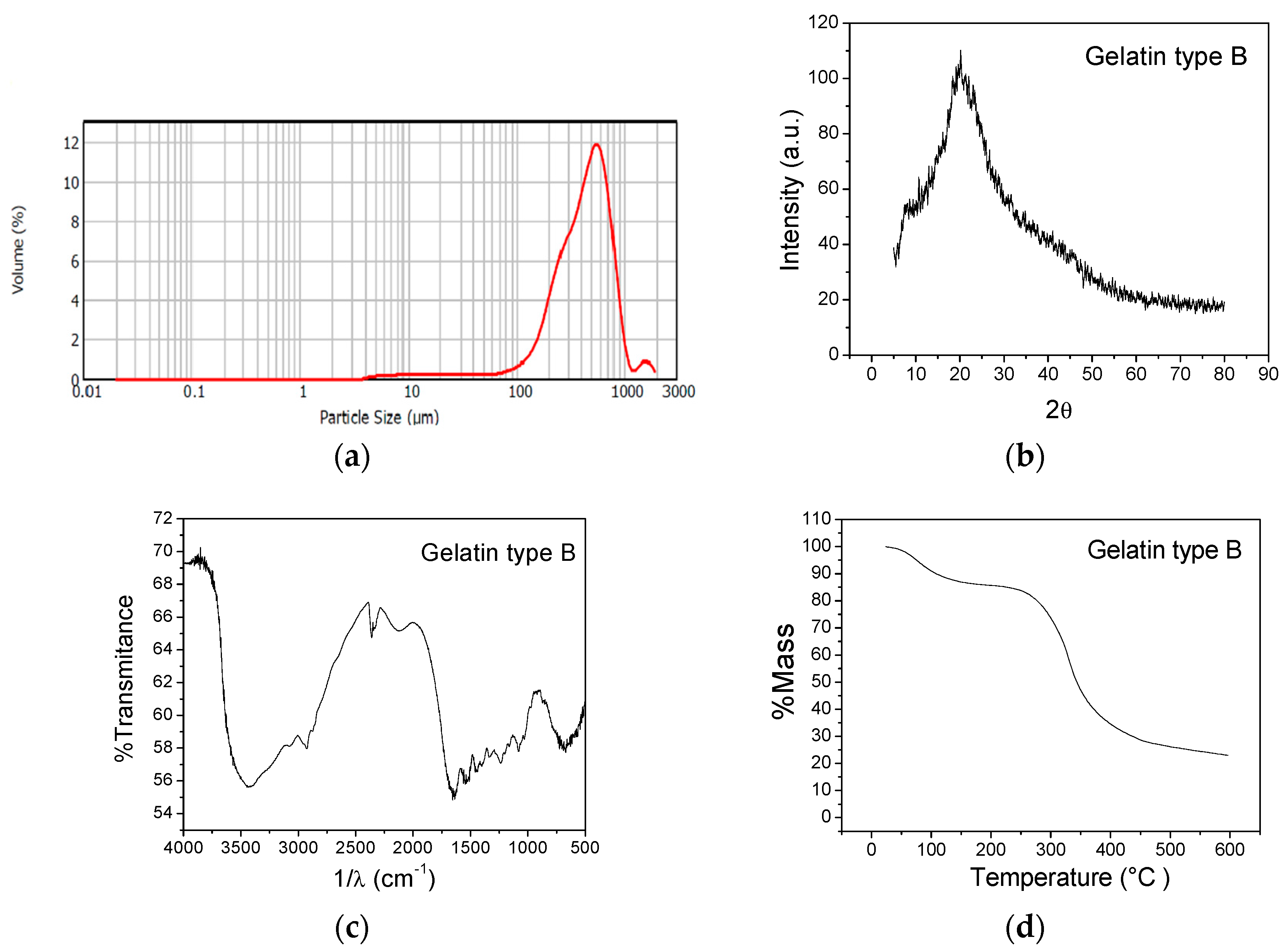
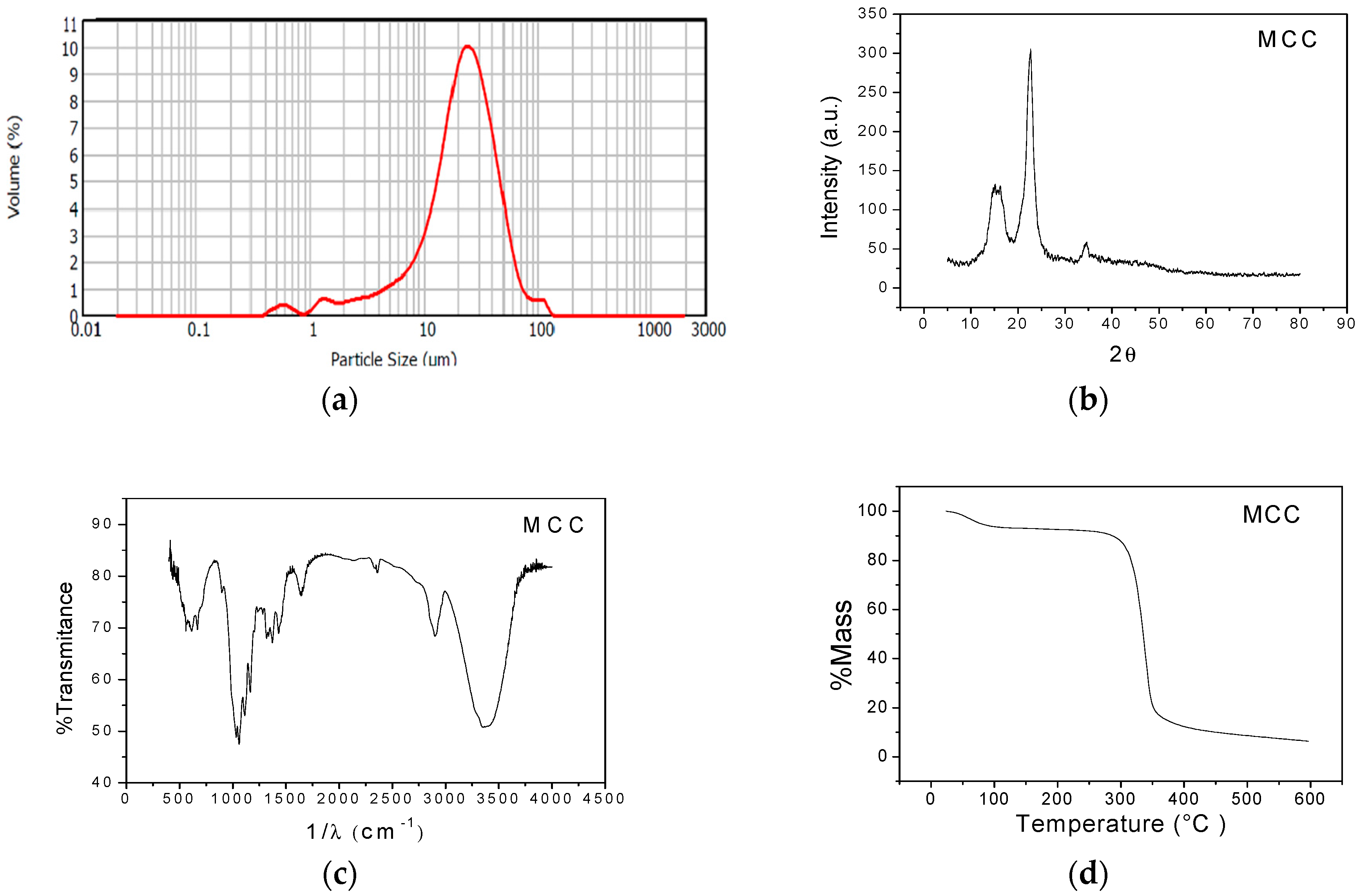
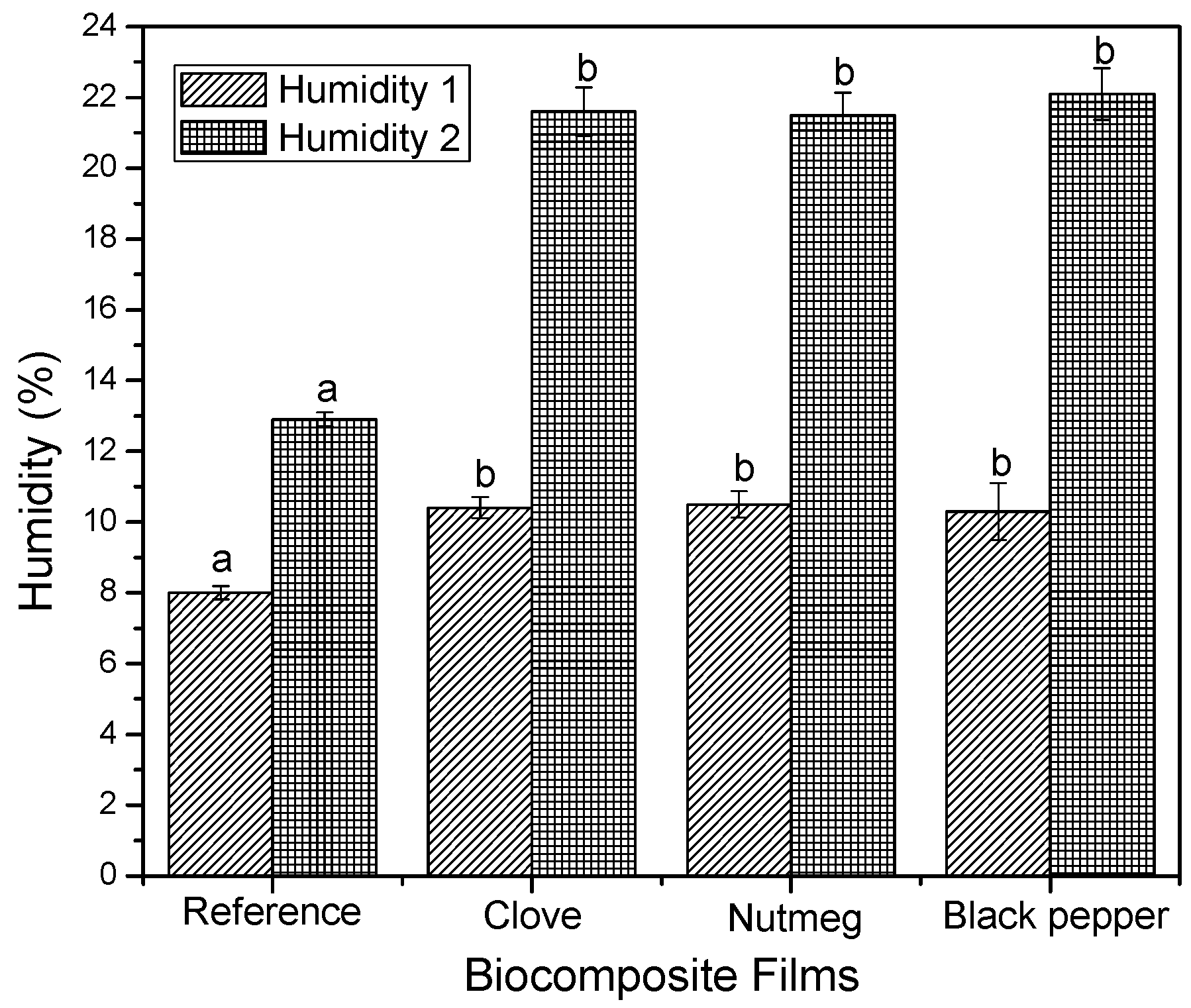


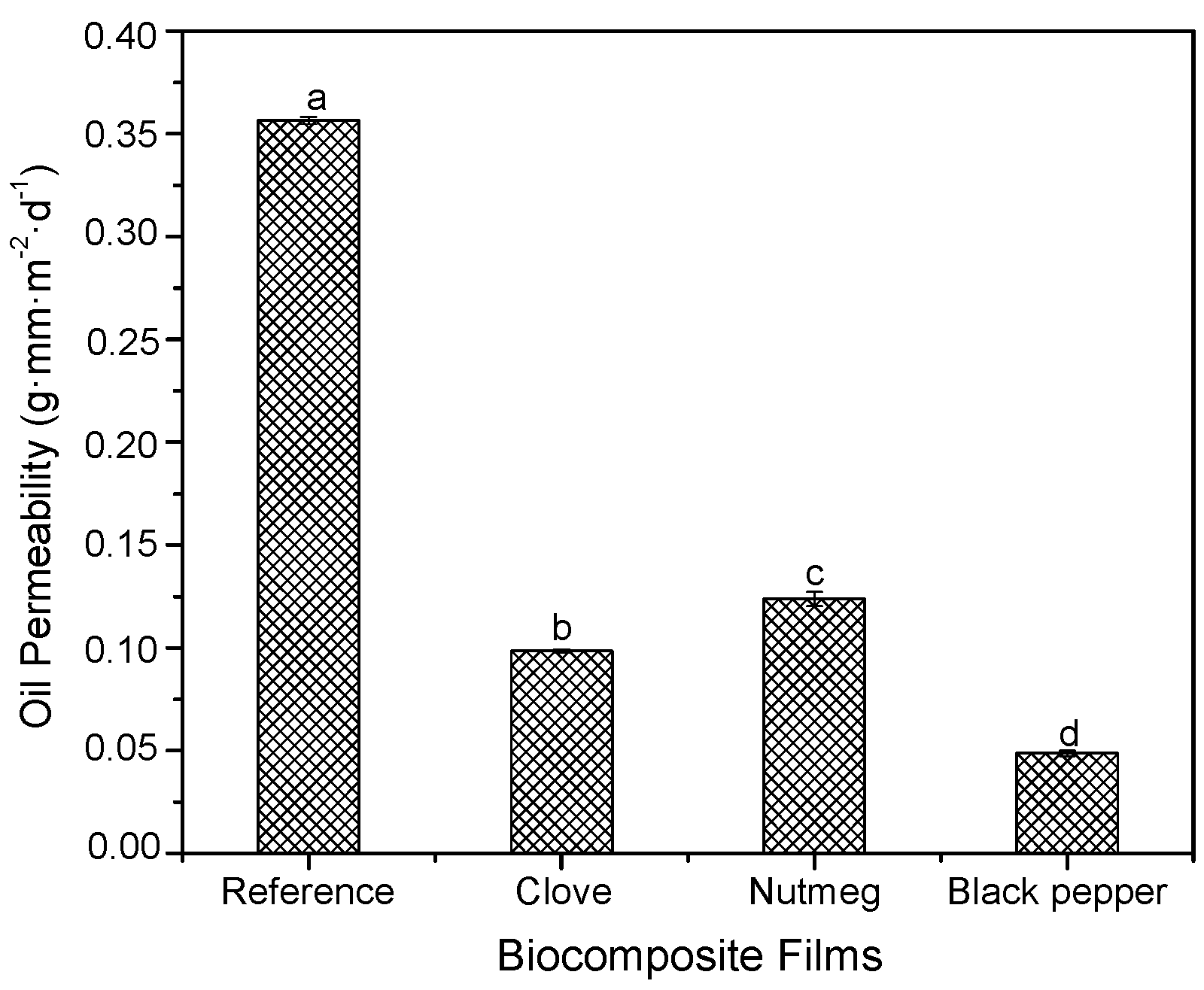
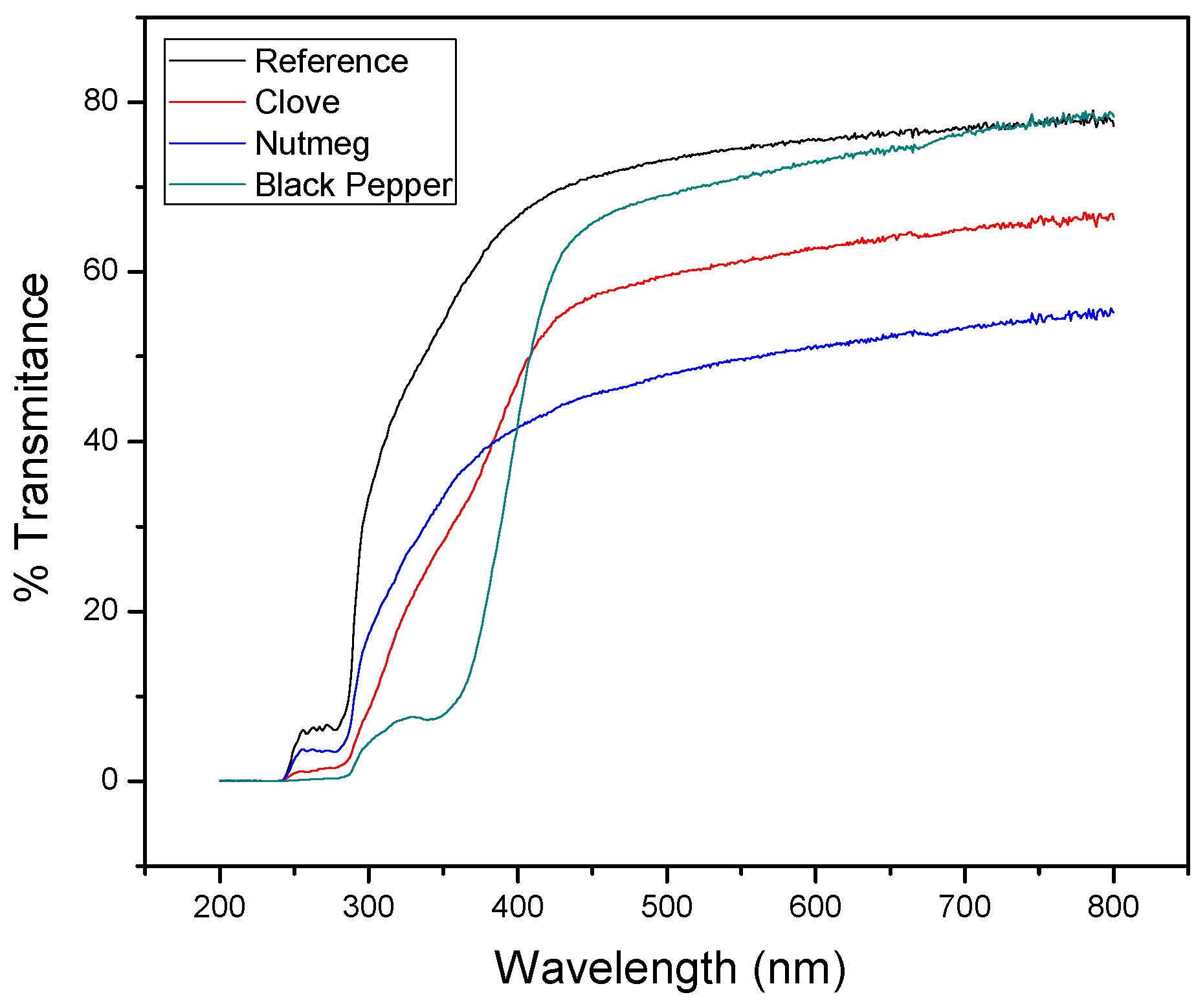
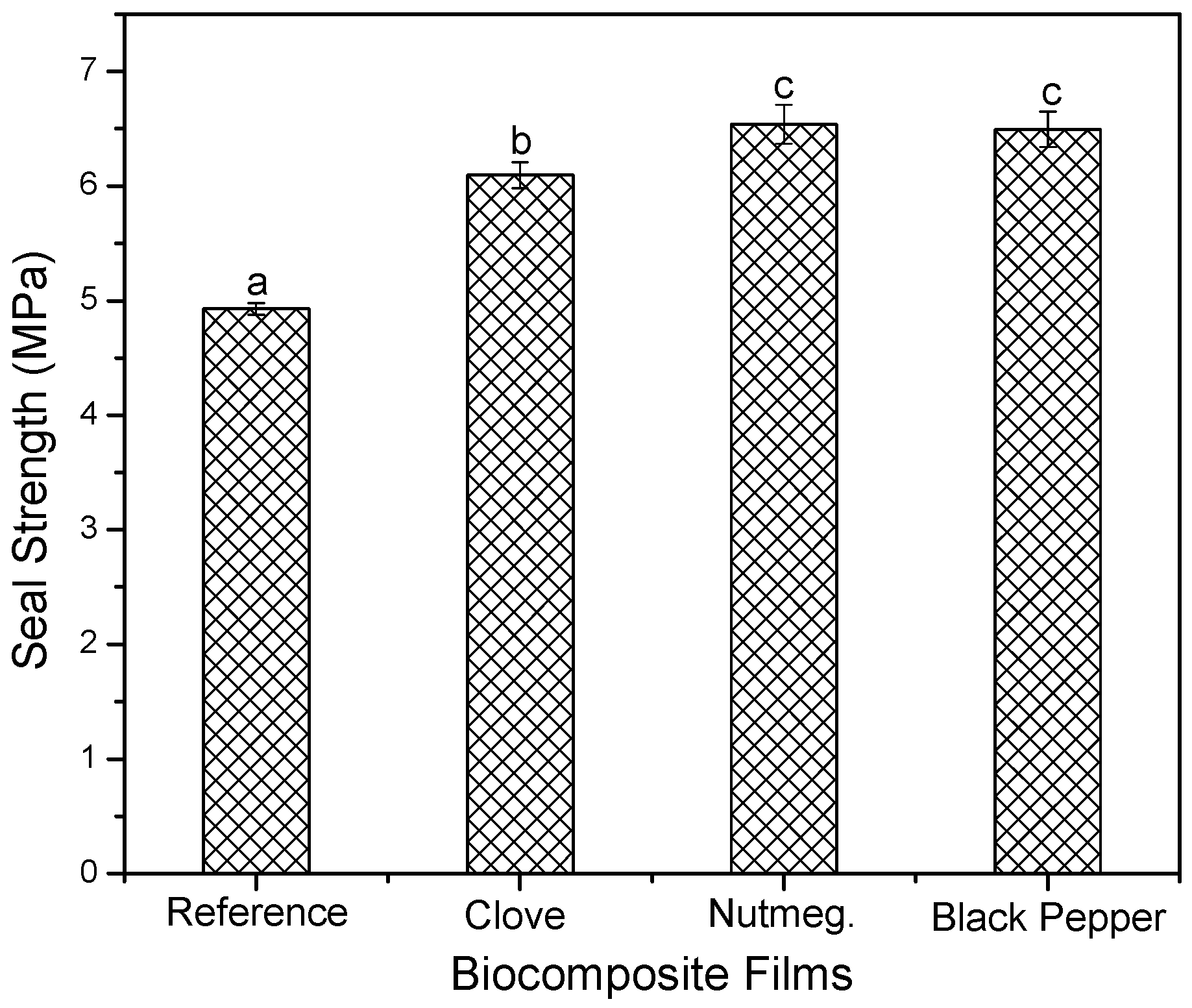



| Biocomposite Films | Color Parameters | |||
|---|---|---|---|---|
| L * | a * | b * | ΔE * | |
| Reference | 92.09 ± 0.094 a | −1.46 ± 0.029 a | 4.73 ± 0.33 a | --- |
| Clove | 89.59 ± 0.22 b | −1.16 ± 0.039 a | 8.65 ± 0.47 b | 4.66 ± 0.51 a |
| Nutmeg | 91.30 ± 0.099 a | −1.42 ± 0.014 a | 5.44 ± 0.12 a | 1.05 ± 0.15 b |
| Black pepper | 90.45 ± 0.77 b | −1.91 ± 0.10 a | 6.73 ± 0.79 c | 2.65 ± 0.99 c |
| Bread Packed in Biocomposite Films | Humidity | pH | aw | % Weight loss | |||||||||||
|---|---|---|---|---|---|---|---|---|---|---|---|---|---|---|---|
| Day 1 | Day 3 | Day 5 | Day 9 | Day 1 | Day 3 | Day 5 | Day 9 | Day 1 | Day 3 | Day 5 | Day 9 | Day 3 | Day 5 | Day 9 | |
| Reference | 26.34 ± 0.79 a | 17.94 ± 0.55 a | 9.61 ± 0.29 a | 7.11 ± 0.2 a | 5.73 ± 0.03 a | 5.71 ± 0.02 a | 5.67 ± 0.02 a | 5.64 ± 0.02 a | 0.84 ± 0.006 a | 0.75 ± 0.006 a | 0.58 ± 0.01 a | 0.44 ± 0.01 a | 45 ± 1.4 a | 54 ± 1.5 a | 34 ± 1.5 a |
| Clove | 25.69 ± 0.95 b | 21.09 ± 0.21 b | 11.61 ± 0.9 b | 8.86 ± 0.39 b | 5.73 ± 0.03 a | 5.65 ± 0.02 a | 5.63 ± 0.02 a | 5.59 ± 0.01 a | 0.84 ± 0.006 a | 0.79 ± 0.005 a | 0.63 ± 0 a | 0.54 ± 0.006 b | 27 ± 1.3 b | 29 ± 1.5 b | 17 ± 0.9 b |
| Nutmeg | 26.00 ± 0.55 a | 21.05 ± 0.53 b | 12.47 ± 0.9 c | 8.55 ± 0.59 b | 5.73 ± 0.03 a | 5.63 ± 0.02 a | 5.61 ± 0.02 a | 5.57 ± 0.02 a | 0.84 ± 0.006 a | 0.79 ± 0.01 a | 0.67 ± 0.047 a | 0.51 ± 0.01 a | 28 ± 1.5 b | 32 ± 1.5 b | 23 ± 1.7 b |
| Black pepper | 25.33 ± 0.49 b | 22.21 ± 0.85 c | 11.37 ± 0.67 b | 9.77 ± 0.45 c | 5.73 ± 0.03 a | 5.64 ± 0.02 a | 5.62 ± 0.02 a | 5.57 ± 0.02 a | 0.84 ± 0.006 a | 0.8 ± 0.01 a | 0.67 ± 0.01 a | 0.59 ± 0.006 b | 20 ± 0.8 c | 17 ± 0.9 c | 13 ± 1.3 c |
| Without film | 25.59 ± 0.3 b | 8.45 ± 0.69 d | 5.87 ± 0.25 d | 4.71 ± 0.81 d | 5.73 ± 0.03 a | 5.59 ± 0.02 a | 5.56 ± 0.01 a | 5.55 ± 0.04 a | 0.84 ± 0.006 a | 0.52 ± 0.01 b | 0.52 ± 0.006 b | 0.4 ± 0.01 c | 69 ± 1.8 d | 41 ± 1.5 d | 24 ± 1.8 b |
| Bread Packed in Biocomposite Films | Count S. aureus (CFU/g) * | Count Molds and Yeasts (CFU/g) * | ||||
|---|---|---|---|---|---|---|
| Day 1 | Day 4 | Day 9 | Day 1 | Day 4 | Day 9 | |
| Reference | <10 | <10 | 50 | <10 | 100 | 460 |
| Clove | <10 | <10 | <10 | <10 | 10 | 50 |
| Nutmeg | <10 | <10 | <10 | <10 | 10 | 40 |
| Black pepper | <10 | <10 | <10 | <10 | <10 | 20 |
| Without film | <10 | <10 | 440 | <10 | 80 | 2440 |
© 2018 by the authors. Licensee MDPI, Basel, Switzerland. This article is an open access article distributed under the terms and conditions of the Creative Commons Attribution (CC BY) license (http://creativecommons.org/licenses/by/4.0/).
Share and Cite
Figueroa-Lopez, K.J.; Andrade-Mahecha, M.M.; Torres-Vargas, O.L. Development of Antimicrobial Biocomposite Films to Preserve the Quality of Bread. Molecules 2018, 23, 212. https://doi.org/10.3390/molecules23010212
Figueroa-Lopez KJ, Andrade-Mahecha MM, Torres-Vargas OL. Development of Antimicrobial Biocomposite Films to Preserve the Quality of Bread. Molecules. 2018; 23(1):212. https://doi.org/10.3390/molecules23010212
Chicago/Turabian StyleFigueroa-Lopez, Kelly J., Margarita María Andrade-Mahecha, and Olga Lucía Torres-Vargas. 2018. "Development of Antimicrobial Biocomposite Films to Preserve the Quality of Bread" Molecules 23, no. 1: 212. https://doi.org/10.3390/molecules23010212






